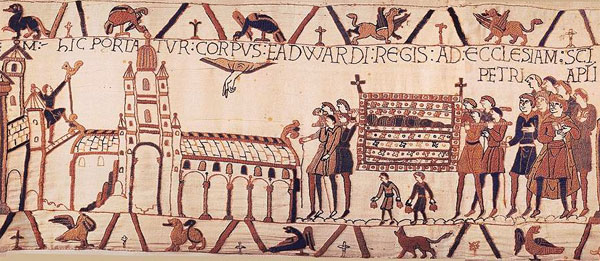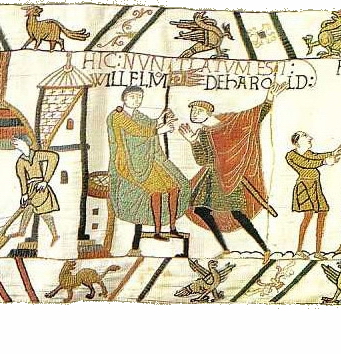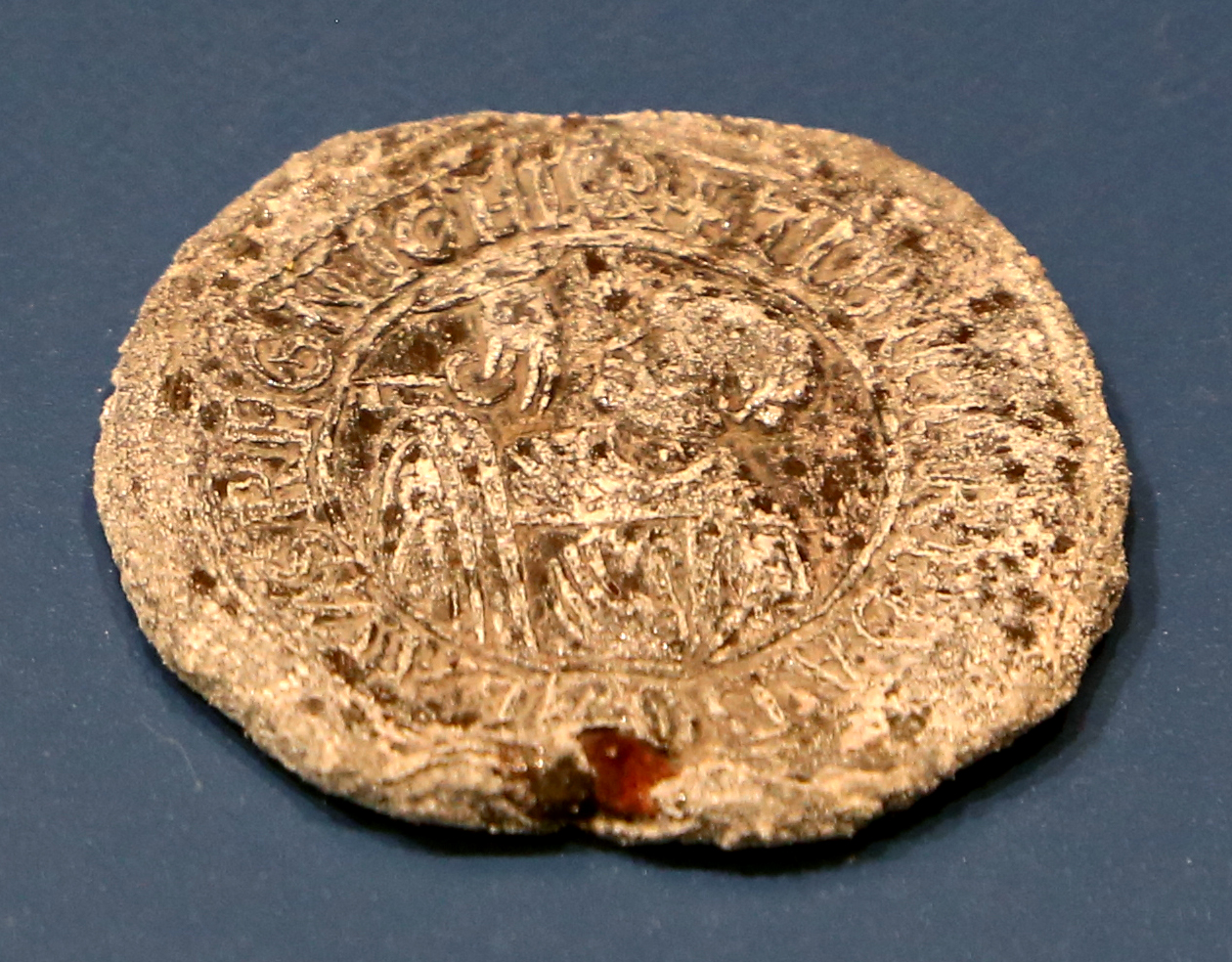|
Archbishop Stigand Of Canterbury
Stigand (died 1072) was an Anglo-Saxon churchman in pre-Norman Conquest England who became Archbishop of Canterbury. His birth date is unknown, but by 1020 he was serving as a royal chaplain and advisor. He was named Bishop of Elmham in 1043, and was later Bishop of Winchester and Archbishop of Canterbury. Stigand was an advisor to several members of the Anglo-Saxon and Norman English royal dynasties, serving six successive kings. Excommunicated by several popes for his pluralism in holding the two sees, or bishoprics, of Winchester and Canterbury concurrently, he was finally deposed in 1070, and his estates and personal wealth were confiscated by William the Conqueror. Stigand was imprisoned at Winchester, where he died without regaining his liberty. Stigand served King Cnut as a chaplain at a royal foundation at Ashingdon in 1020, and as an advisor then and later. He continued in his role of advisor during the reigns of Cnut's sons, Harold Harefoot and Harthacnut. When C ... [...More Info...] [...Related Items...] OR: [Wikipedia] [Google] [Baidu] |
Archbishop Of Canterbury
The archbishop of Canterbury is the senior bishop and a principal leader of the Church of England, the ceremonial head of the worldwide Anglican Communion and the diocesan bishop of the Diocese of Canterbury. The current archbishop is Justin Welby, who was enthroned at Canterbury Cathedral on 21 March 2013. Welby is the 105th in a line which goes back more than 1400 years to Augustine of Canterbury, the "Apostle to the English", sent from Rome in the year 597. Welby succeeded Rowan Williams. From the time of Augustine until the 16th century, the archbishops of Canterbury were in full communion with the See of Rome and usually received the pallium from the pope. During the English Reformation, the Church of England broke away from the authority of the pope. Thomas Cranmer became the first holder of the office following the English Reformation in 1533, while Reginald Pole was the last Roman Catholic in the position, serving from 1556 to 1558 during the Counter-Reformation. ... [...More Info...] [...Related Items...] OR: [Wikipedia] [Google] [Baidu] |
Harold Harefoot
Harold I (died 17 March 1040), also known as Harold Harefoot, was King of the English from 1035 to 1040. Harold's nickname "Harefoot" is first recorded as "Harefoh" or "Harefah" in the twelfth century in the history of Ely Abbey, and according to some late medieval chroniclers it meant that he was "fleet of foot". The son of Cnut the Great and Ælfgifu of Northampton, Harold was elected regent of England following the death of his father in 1035. He initially ruled England in place of his brother Harthacnut, who was stuck in Denmark due to a rebellion in Norway which had ousted their brother Svein. Although Harold had wished to be crowned king since 1035, Æthelnoth, Archbishop of Canterbury, refused to do so. It was not until 1037 that Harold, supported by earl Leofric and many others, was officially proclaimed king. The same year, Harold's two step-brothers Edward and Alfred returned to England with a considerable military force. Alfred was captured by Earl Godwin, who had ... [...More Info...] [...Related Items...] OR: [Wikipedia] [Google] [Baidu] |
Æthelmær Of Elmham
эthelmaer (or эthelmэr) was a medieval Bishop of Elmham. Life Æthelmaer was the brother of Stigand, Archbishop of Canterbury. He was consecrated in 1047 and deprived of office circa 11 April 1070 by Ermenfrid, bishop of Sion The Diocese of Sion ( la, Dioecesis Sedunensis, french: Diocèse de Sion, german: Bistum Sitten) is a Catholic ecclesiastical territory in the canton of Valais, Switzerland. It is the oldest bishopric in the country and one of the oldest north o ..., who was the papal legate to England. References External links * Bishops of Elmham {{England-bishop-stub ... [...More Info...] [...Related Items...] OR: [Wikipedia] [Google] [Baidu] |
Norwich
Norwich () is a cathedral city and district of Norfolk, England, of which it is the county town. Norwich is by the River Wensum, about north-east of London, north of Ipswich and east of Peterborough. As the seat of the See of Norwich, with one of the country's largest medieval cathedrals, it is the largest settlement and has the largest urban area in East Anglia. The population of the Norwich City Council local authority area was estimated to be 144,000 in 2021, which was an increase from 143,135 in 2019. The wider built-up area had a population of 213,166 in 2019. Heritage and status Norwich claims to be the most complete medieval city in the United Kingdom. It includes cobbled streets such as Elm Hill, Timber Hill and Tombland; ancient buildings such as St Andrew's Hall; half-timbered houses such as Dragon Hall, The Guildhall and Strangers' Hall; the Art Nouveau of the 1899 Royal Arcade; many medieval lanes; and the winding River Wensum that flows through the city ... [...More Info...] [...Related Items...] OR: [Wikipedia] [Google] [Baidu] |
East Anglia
East Anglia is an area in the East of England, often defined as including the counties of Norfolk, Suffolk and Cambridgeshire. The name derives from the Anglo-Saxon kingdom of the East Angles, a people whose name originated in Anglia, in what is now Northern Germany. Area Definitions of what constitutes East Anglia vary. The Anglo-Saxon Kingdom of East Anglia, established in the 6th century, originally consisted of the modern counties of Norfolk and Suffolk and expanded west into at least part of Cambridgeshire, typically the northernmost parts known as The Fens. The modern NUTS 3 statistical unit of East Anglia comprises Norfolk, Suffolk and Cambridgeshire (including the City of Peterborough unitary authority). Those three counties have formed the Roman Catholic Diocese of East Anglia since 1976, and were the subject of a possible government devolution package in 2016. Essex has sometimes been included in definitions of East Anglia, including by the London Society o ... [...More Info...] [...Related Items...] OR: [Wikipedia] [Google] [Baidu] |
Papal Legate
300px, A woodcut showing Henry II of England greeting the pope's legate. A papal legate or apostolic legate (from the ancient Roman title ''legatus'') is a personal representative of the pope to foreign nations, or to some part of the Catholic Church. He is empowered on matters of Catholic faith and for the settlement of ecclesiastical matters. The legate is appointed directly by the pope—the bishop of Rome and head of the Catholic Church. Hence a legate is usually sent to a government, a sovereign or to a large body of believers (such as a national church) or to take charge of a major religious effort, such as an ecumenical council, a crusade to the Holy Land, or even against a heresy such as the Cathars. The term ''legation'' is applied both to a legate's mandate and to the territory concerned (such as a state, or an ecclesiastical province). The relevant adjective is ''legatine''. History 200px, Cardinal Thomas Wolsey, papal legate to England during the reign of Hen ... [...More Info...] [...Related Items...] OR: [Wikipedia] [Google] [Baidu] |
Court (royal)
A royal court, often called simply a court when the royal context is clear, is an extended royal household in a monarchy, including all those who regularly attend on a monarch, or another central figure. Hence, the word "court" may also be applied to the coterie of a senior member of the nobility. Royal courts may have their seat in a designated place, several specific places, or be a mobile, itinerant court. In the largest courts, the royal households, many thousands of individuals comprised the court. These courtiers included the monarch or noble's camarilla and retinue, household, nobility, clergy, those with court appointments, bodyguards, and may also include emissaries from other kingdoms or visitors to the court. Prince étranger, Foreign princes and foreign nobility in exile may also seek refuge at a court. Near East, Near Eastern and Far East, Far Eastern courts often included the harem and Concubinage, concubines as well as eunuchs who fulfilled a variety of functions. ... [...More Info...] [...Related Items...] OR: [Wikipedia] [Google] [Baidu] |
Archbishop Of York
The archbishop of York is a senior bishop in the Church of England, second only to the archbishop of Canterbury. The archbishop is the diocesan bishop of the Diocese of York and the metropolitan bishop of the province of York, which covers the northern regions of England (north of the Trent) as well as the Isle of Man. The archbishop's throne ('' cathedra'') is in York Minster in central York and the official residence is Bishopthorpe Palace in the village of Bishopthorpe outside York. The current archbishop is Stephen Cottrell, since the confirmation of his election on 9 July 2020. History Roman There was a bishop in Eboracum (Roman York) from very early times; during the Middle Ages, it was thought to have been one of the dioceses established by the legendary King Lucius. Bishops of York are known to have been present at the councils of Arles (Eborius) and Nicaea (unnamed). However, this early Christian community was later destroyed by the pagan Anglo-Saxons and ... [...More Info...] [...Related Items...] OR: [Wikipedia] [Google] [Baidu] |
Ealdred (archbishop)
Ealdred (or Aldred; died 11 September 1069) was Abbot of Tavistock, Bishop of Worcester, and Archbishop of York in early medieval England. He was related to a number of other ecclesiastics of the period. After becoming a monk at the monastery at Winchester, he was appointed Abbot of Tavistock Abbey in around 1027. In 1046 he was named to the Bishopric of Worcester. Ealdred, besides his episcopal duties, served Edward the Confessor, the King of England, as a diplomat and as a military leader. He worked to bring one of the king's relatives, Edward the Exile, back to England from Hungary to secure an heir for the childless king. In 1058 he undertook a pilgrimage to Jerusalem, the first bishop from England to do so.Barlow ''Edward the Confessor'' pp. 208–209 As administrator of the Diocese of Hereford, he was involved in fighting against the Welsh, suffering two defeats at the hands of raiders before securing a settlement with Gruffydd ap Llywelyn, a Welsh ruler. In 1060, ... [...More Info...] [...Related Items...] OR: [Wikipedia] [Google] [Baidu] |
Pope Alexander II
Pope Alexander II (1010/1015 – 21 April 1073), born Anselm of Baggio, was the head of the Roman Catholic Church and ruler of the Papal States from 1061 to his death in 1073. Born in Milan, Anselm was deeply involved in the Pataria reform movement. Elected according to the terms of his predecessor's bull, ''In nomine Domini'', Anselm's was the first election by the cardinals without the participation of the people and minor clergy of Rome. He also authorized the Norman Conquest of England in 1066. Early life and work Anselm was born in the parish of Cesano Boscone in the town of Corsico some 7 km (5 mi) from Milan of a noble family. The family took its name from Baggio. a suburb of Milan, where the family held the office of "captain". According to the ''Liber pontificalis'', his father's name was Anselmus or Ardericus. Contemporary sources do not provide any information on where Anselm might have obtained his education. It was traditionally believed that An ... [...More Info...] [...Related Items...] OR: [Wikipedia] [Google] [Baidu] |
Pope Nicholas II
Pope Nicholas II ( la, Nicholaus II; c. 990/995 – 27 July 1061), otherwise known as Gerard of Burgundy, was the head of the Catholic Church and ruler of the Papal States from 24 January 1059 until his death in 27 July 1061. At the time of his election, he was bishop of Florence. During his Papacy, Nicholas II successfully expanded the influence of the papacy in Milan and southern Italy. He was also responsible for passing papal election reforms which resulted in greater papal influence in electing new Popes. Early life Gerard of Burgundy was born in Chevron, in what is now Savoy. He was canon at Liège. In 1046 he became bishop of Florence, where he restored the canonical life among the clergy of numerous churches.Weber, Nicholas. "Pope Nicholas II." The Catholic Encyclopedia Vol. 11. New York: ... [...More Info...] [...Related Items...] OR: [Wikipedia] [Google] [Baidu] |
Province Of Canterbury
The Province of Canterbury, or less formally the Southern Province, is one of two ecclesiastical provinces which constitute the Church of England. The other is the Province of York (which consists of 12 dioceses). Overview The Province consists of 30 dioceses, covering roughly two-thirds of England, parts of Wales, all of the Channel Islands and continental Europe, Morocco, Turkey, Mongolia and the territory of the former Soviet Union (under the jurisdiction of the Diocese of Gibraltar in Europe). The Province previously also covered all of Wales but lost most of its jurisdiction in 1920, when the then four dioceses of the Church in Wales were disestablished and separated from Canterbury to form a distinct ecclesiastical province of the Anglican Communion. The Province of Canterbury retained jurisdiction over eighteen areas of Wales that were defined as part of "border parishes", parishes whose ecclesiastical boundaries straddled the temporal boundary between England and Wale ... [...More Info...] [...Related Items...] OR: [Wikipedia] [Google] [Baidu] |





